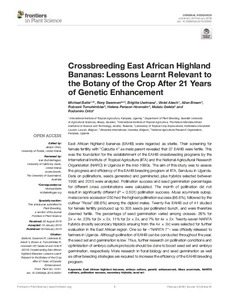| dc.contributor.author | Batte, M. |
| dc.contributor.author | Swennen, R. |
| dc.contributor.author | Uwimana, B. |
| dc.contributor.author | Akech, V. |
| dc.contributor.author | Brown, A. |
| dc.contributor.author | Tumuhimbise, R. |
| dc.contributor.author | Hovmalm, H.P. |
| dc.contributor.author | Geleta, M. |
| dc.contributor.author | Ortiz, R. |
| dc.date.accessioned | 2019-12-04T11:30:14Z |
| dc.date.available | 2019-12-04T11:30:14Z |
| dc.date.issued | 2019-02-05 |
| dc.identifier.citation | Batte, M., Swennen, R., Uwimana, B., Akech, V., Brown, A., Tumuhimbise, R., ... & Ortiz, R. (2019). Crossbreeding east African highland bananas: lessons learnt relevant to the botany of the crop after 21 years of genetic enhancement. Frontiers in Plant Science, 10(81), 1-9. |
| dc.identifier.issn | 1664-462X |
| dc.identifier.uri | https://hdl.handle.net/20.500.12478/5231 |
| dc.description | Open Access Journal |
| dc.description.abstract | East African highland bananas (EAHB) were regarded as sterile. Their screening for female fertility with “Calcutta 4” as male parent revealed that 37 EAHB were fertile. This was the foundation for the establishment of the EAHB crossbreeding programs by the International Institute of Tropical Agriculture (IITA) and the National Agricultural Research Organization (NARO) in Uganda in the mid-1990s. The aim of this study was to assess the progress and efficiency of the EAHB breeding program at IITA, Sendusu in Uganda. Data on pollinations, seeds generated and germinated, plus hybrids selected between 1995 and 2015 were analyzed. Pollination success and seed germination percentages for different cross combinations were calculated. The month of pollination did not result in significantly different (P = 0.501) pollination success. Musa acuminata subsp. malaccensis accession 250 had the highest pollination success (66.8%), followed by the cultivar “Rose” (66.6%) among the diploid males. Twenty-five EAHB out of 41 studied for female fertility produced up to 305 seeds per pollinated bunch, and were therefore deemed fertile. The percentage of seed germination varied among crosses: 26% for 2x × 4x, 23% for 2x × 2x, 11% for 3x × 2x, and 7% for 4x × 2x. Twenty-seven NARITA hybrids (mostly secondary triploids ensuing from the 4x × 2x) were selected for further evaluation in the East African region. One so far –“NARITA 7”– was officially released to farmers in Uganda. Although pollination of EAHB can be conducted throughout the year, the seed set and germination is low. Thus, further research on pollination conditions and optimization of embryo culture protocols should be done to boost seed set and embryo germination, respectively. More research in floral biology and seed germination as well as other breeding strategies are required to increase the efficiency of the EAHB breeding program. |
| dc.description.sponsorship | Bill & Melinda Gates Foundation |
| dc.format.extent | 1-9 |
| dc.language.iso | en |
| dc.rights | CC-BY-4.0 |
| dc.subject | East African |
| dc.subject | Highland |
| dc.subject | Bananas |
| dc.subject | Embryo Culture |
| dc.subject | Musa Acuminata |
| dc.subject | Cultivars |
| dc.subject | Pollination |
| dc.subject | Success |
| dc.subject | Seed Set |
| dc.subject | Genetics |
| dc.title | Crossbreeding east African highland bananas: lessons learnt relevant to the botany of the crop after 21 years of genetic enhancement |
| dc.type | Journal Article |
| dc.description.version | Peer Review |
| cg.contributor.crp | Agriculture for Nutrition and Health |
| cg.contributor.crp | Roots, Tubers and Bananas |
| cg.contributor.affiliation | International Institute of Tropical Agriculture |
| cg.contributor.affiliation | National Agricultural Research Organization, Kampala |
| cg.contributor.affiliation | Swedish University of Agricultural Sciences |
| cg.coverage.region | Africa |
| cg.coverage.region | East Africa |
| cg.coverage.country | Uganda |
| cg.creator.identifier | Rony Swennen: 0000-0002-5258-9043 |
| cg.creator.identifier | Brigitte Uwimana: 0000-0001-7460-9001 |
| cg.creator.identifier | Allen Brown: 0000-0002-4468-5932 |
| cg.researchtheme | BIOTECH & PLANT BREEDING |
| cg.isijournal | ISI Journal |
| cg.authorship.types | CGIAR and developing country institute |
| cg.iitasubject | Banana |
| cg.iitasubject | Genetic Improvement |
| cg.iitasubject | Plant Breeding |
| cg.iitasubject | Tissue Culture |
| cg.journal | Frontiers in Plant Science |
| cg.howpublished | Formally Published |
| cg.accessibilitystatus | Open Access |
| local.dspaceid | 103080 |
| cg.targetaudience | Scientists |
| cg.identifier.doi | https://dx.doi.org/10.3389/fpls.2019.00081 |

